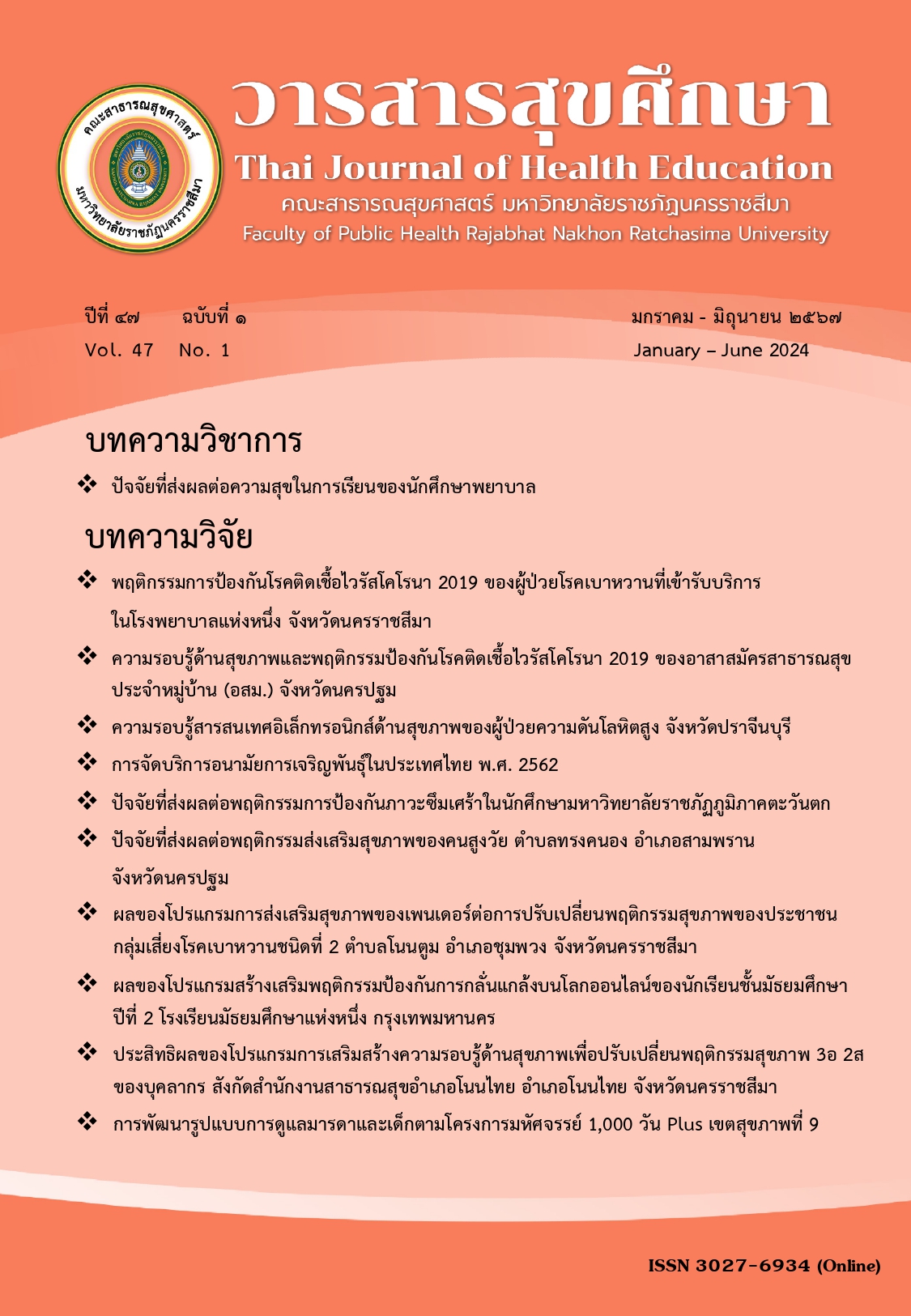The Effects of Applying Pender's Health Promotion Program on Improving Risk People with Type 2 Diabetes Mellitus Non Tum Sub-district, Chum Phuang District, Nakhon Ratchasima Province
Main Article Content
Abstract
This quasi-experimental study aimed to the effects program of applying Pender's health promotion theory with behavior change risk diabetes mellitus type 2 of people Non Tum Sub-district, Chum Phuang District, Nakhon Ratchasima Province. The samples were risk people with type 2 diabetes mellitus divided into two groups. The experimental and control group were consisted of 35 participate group. The experimental group was received program of applying Pender's health promotion theory and the control group received regular health promotion programs by simple random sampling and the trial period 12 weeks. The instrument used for data collection was personal questionnaire, health promotion behavior assessment (3E.2S.) and fingertip sugar level recording and body mass index form. Frequencies, percentage,mean, standard deviation, compare average score values paired samples t-test and independent samples t-test were applied for data analysis.
The results of this study were as follows: After receiving the program of applying Pender's health promotion theory the risk diabetes mellitus type 2 of people Non Tum Sub-district, Chum Phuang District, Nakhon Ratchasima Province, the experimental group hadsignificantly health behavior (3E.2S), effect on fingertip sugar levels and body mass index than before receiving the health promotion program and better control group at 0.01 level. Such the health promotion programs can be used to expand their results and apply in other areas to the provincial and national levels.
Article Details

This work is licensed under a Creative Commons Attribution-NonCommercial-NoDerivatives 4.0 International License.
References
World Health Organization. Diabetes Fact sheet. [internet]. 2016. [cited 2015 October 8]. Available from: http://www.who.int/mediacentre/factsheets/fs312/en/.
Diabetes World Health Organization. [Internet]. 2020. [cited 2021 Aus 26]. Available from: https://www.who.int/news-room/fact-sheets/detail/diabetes.
International Diabetes Federation. IDF Diabetes Atlas, 8th ed. Brussels, Belgium: International Diabetes Federation. 2017.
American Diabetes Association. Classification and Diagnosis of Diabetes. Diabetes Care 2017; 40 (Suppl. 1): S11-S24; DOI: 10.2337/dc17-S005.
World Health Organization. Diabetes fact sheet. [Internet]. 2021. [cited 2023 March 13]. Available from: https://www.who.int/news-room/fact-sheets/detail/diabetes.
สมาคมโรคเบาหวานแห่งประเทศไทยสมาคมต่อมไร้ท่อแห่งประเทศไทย กรมการแพทย์ และสำนักงานหลักประกันสุขภาพห่งชาติ. แนวทางเวชปฏิบัติสาหรับโรคเบาหวาน พ.ศ.2554. กรุงเทพมหานคร: บริษัทศรีเมืองการพิมพ์ จำกัด. 2564.
สำนักโรคไม่ติดต่อ. แผนงานควบคุมโรคไม่ติดต่อปี 2560–2564. [ออนไลน์]. 2566.[ สืบค้น 2566 มกราคม 8] จาก: http://plan.ddc.moph.go.th/meeting 30_1augsep/meetting301/Documents/ AD.pdf.
ประภาส บารมี และ จักรพันธ์ บุญอ่อง. การปรับเปลี่ยนพฤติกรรมกลุ่มเสี่ยงโรคเบาหวานด้วย4ป.กรณีศึกษากลุ่มเสี่ยงโรคเบาหวานตาบลบ้านกลางอาเภอวังทองจังหวัดพิษณุโลก. วารสารสหวิชาการเพื่อสุขภาพ. 2566; 5(1): 25-37.
สำนักงานสาธารณสุขอำเภอชุมพวง. ศูนย์ข้อมูลภาวะสุขภาพ. สำนักงานสาธารณสุข อำเภอชุมพวง กระทรวงสาธารณสุข จังหวัดนครราชสีมา. 2565.
โรงพยาบาลส่งเสริมสุขภาพตำบลตูมใหญ่. ศูนย์ข้อมูลภาวะสุขภาพ. โรงพยาบาลส่งเสริมสุขภาพตำบลตูมใหญ่ องค์การบริหารส่วนจังหวัดนครราชสีมา จังหวัดนครราชสีมา. 2565.
ชุลีกร ด่านยุทธศิลป์. แบบจำลองการส่งเสริมสุขภาพของเพนเดอร์และการประยุกต์ใช้ในการปฏิบัติการส่งเสริมสุขภาพทางการพยาบาล. วารสารพยาบาลสงขลานครินทร์. 2561; 38(2): 132-141.
Pender, N.J., Murdaugh. CL., & Parsons, MA. Health Promotion in Nursing Practice. (4rd ed.). USA: Appleton & Lange 2011.
พัชราวรรณ จันทร์เพชร, เพชรัตน์ ศิริสุวรรณ และฉัตรลดา ดีพร้อม. ผลของโปรแกรมการส่งเสริมสุขภาพกลุ่มเสี่ยงโรคเบาหวานในเขตพื้นที่ตำบลเมืองไพร อำเภอเสลภูมิ จังหวัดร้อยเอ็ด. วารสารสำนักงานป้องกันควบคุมโรคที่ 7 ขอนแก่น. 2563; 27(1): 55-62.
Cohen. Statistic power Analysis for Behavioral Sciences. New York: Academic Press.1969.
ธณกร ปัญญาใสโสภณ. ระเบียบวิธีวิจัยสำหรับการจัดการสร้างเสริมสุขภาพ. นครราชสีมา: ห้างหุ้นส่วนจำกัด เลิศศิลป์ สาส์ณ โฮลดิ้ง. 2564.
ชูศรี วงศ์รัตนะ. เทคนิคการสร้างเครื่องมือวิจัย: การนำไปใช้อย่างมืออาชีพ. กรุงเทพฯ : อมรการพิมพ์. 2560.
เกสราวรรณ ประดับพจน์ และศิริลักษณ์ ประดับพจน์, ผลของโปรแกรมปรับเปลี่ยนพฤติกรรมสุขภาพ 3 self ต่อการเปลี่ยนแปลงของระดับน้ำตาลในเลือด ความดันโลหิตและเส้นรอบเอวของกลุ่มเสี่ยงโรคเบาหวาน และโรคความดันโลหิตสูง อำเภอพรหมคีรี จังหวัดนครศรีธรรมราช. วารสารมหาจุฬานาครทรรศน์. 2564; 8(5): 148-161.
ทิพย์สุมน จิตตวงศพันธุ์, ปิ่นหทัย และรุ้งนภา ชัยรัตน์, ผลของโปรแกรมส่งเสริมการรับรู้สมรรถนะแห่งตนต่อพฤติกรรมการป้องกันโรคและดัชนีมวลกายในกลุ่มเสี่ยงเบาหวานที่ชนิด 2. วารสารพยาบาล. 2564; 48(4): 243-255.
เพ็ญวดี โรจน์เรืองนนท์ และคณะ, ศึกษาผลของโปรแกรมการส่งเสริมความสามารถของตนเองเพื่อปรับเปลี่ยนพฤติกรรมการบริโภคอาหารในกลุ่มเสี่ยง โรคเบาหวานแขวงคลองต้นไทร เขตคลองสาน กรุงเทพมหานคร. วารสารกรมการแพทย์. 2564; 46(3): 81-88.
สุภาวดี กลัดทอง และณรินี แย้มสกุล, ผลของโปรแกรมสุขศึกษาเพื่อการเสริมสร้างความรอบรู้ด้านสุขภาพตามหลัก 2 อ.ต่อความรอบรู้ด้านสุขภาพ พฤติกรรมสุขภาพ และระดับน้ำตาลในเลือดของกลุ่มเสี่ยงโรคเบาหวานชนิดที่ 2. วารสารวิชาการและการพยาบาล วิทยาลัยพยาบาลบรมราชชนนี จักรีรัช. 2564; 1(2): 14-26.


